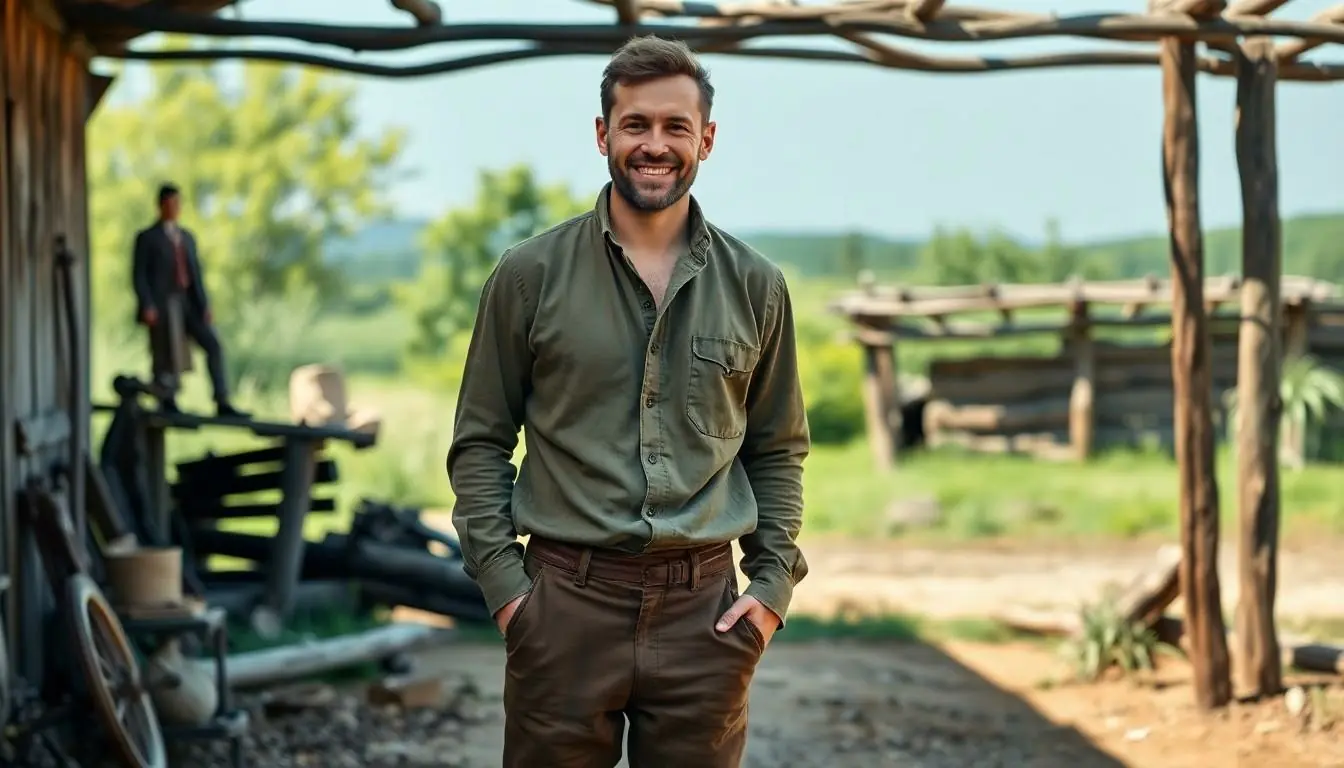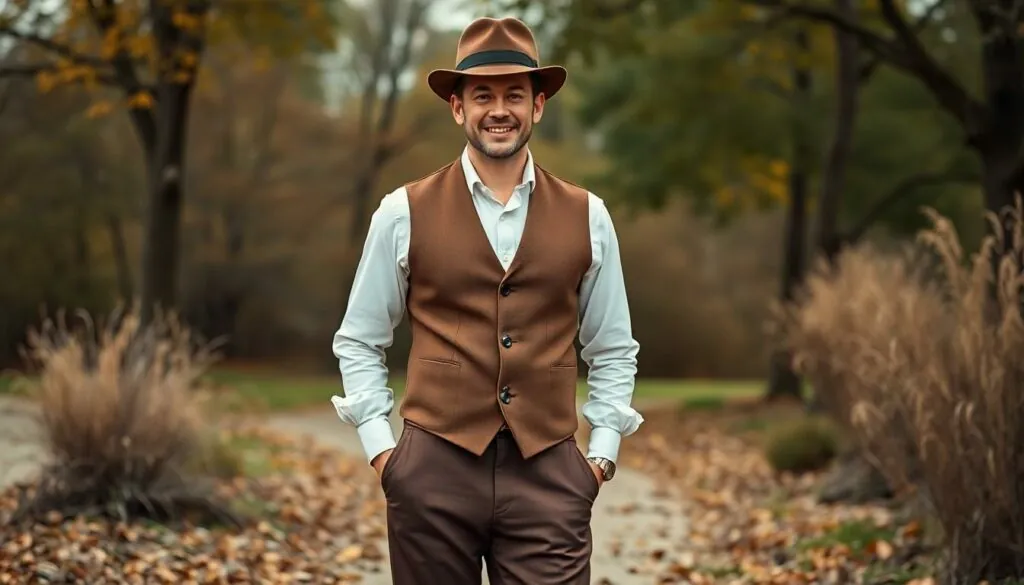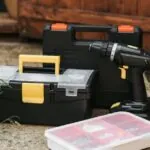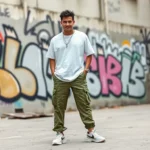Table of Contents
ToggleImagine stepping into a time machine and landing in the 1800s, where men strolled the streets in dapper attire that could make even a modern fashionista swoon. Casual men’s wear back then was a delightful mix of comfort and class, proving that style doesn’t have to come with a stiff collar or a top hat. From waistcoats that hugged the torso to trousers that were surprisingly roomy, the 1800s offered a unique flair that’s hard to resist.
But let’s be honest—who wouldn’t want to swap their sweatpants for some finely tailored breeches? The charm of casual 1800s menswear lies in its ability to balance sophistication with a laid-back vibe. So grab your bowler hat and prepare to dive into a world where every outfit tells a story, and fashion was as much about personality as it was about fabric.
Overview of Casual 1800s Mens Wear
Casual menswear in the 1800s showcased a balance between comfort and elegance. Tailored waistcoats often accompanied loose-fitting trousers, providing a relaxed appearance while maintaining an element of sophistication. Shirt styles varied, with high collars and sometimes ruffled designs adding flair to outfits.
Fabric choices reflected both practicality and style. Wool remained popular due to its durability and warmth, while cotton offered breathability during warmer months. Rich colors and intricate patterns adorned many garments, allowing for personal expression within a gentleman’s wardrobe.
Accessories played a vital role in completing the look. Flat caps, bowler hats, and cravats provided versatility and added character. Footwear ranged from sturdy boots to polished shoes, with quality materials enhancing overall appeal.
The idea of appropriate attire for leisure activities emerged during this period. Gentlemen often donned specific outfits for outings such as picnics or leisurely strolls. Casual attire emphasized a relaxed yet put-together presentation, reflecting social status and personal style.
Influences from different regions seeped into mainstream fashion, creating a melting pot of styles. Urban centers like Paris and London led trends, while rural areas incorporated more functional elements into everyday wear. Craftsmanship remained paramount, with skilled tailors ensuring a perfect fit and attention to detail.
Understanding casual menswear from the 1800s offers insights into the evolution of men’s fashion. The era’s emphasis on individuality set the foundation for future styles, balancing practicality with sophisticated aesthetics.
Key Materials Used

Men’s casual wear in the 1800s showcased a variety of materials that balanced comfort and style. These fabrics defined the era’s fashion and contributed significantly to its unique appeal.
Fabrics and Textiles
Cotton served as a popular choice for everyday shirts and trousers due to its breathability. Wool provided warmth and durability, making it ideal for jackets and waistcoats. Linen emerged as a lightweight option, particularly favored in summer attire. Silk offered a touch of luxury in neckwear and detailing, reflecting personal style without compromising comfort. Overall, the blend of these textiles allowed gentlemen to navigate social events while remaining at ease.
Colors and Patterns
Earthy tones dominated, with shades like browns, greens, and grays reflecting practicality. Stripes became common in waistcoats and shirts, adding subtle texture. Plaid patterns often appeared in outer garments, enhancing visual interest. Dark colors provided a formal touch, while lighter hues signaled casual leisure. This color palette and pattern variety contributed significantly to the versatility of 1800s menswear, allowing for creativity and personal expression in daily outfits.
Typical Outfits and Styles
Men’s casual wear in the 1800s featured a blend of comfort, elegance, and personal expression, defining the era’s unique fashion landscape. A variety of outfits catered to daily activities and leisure occasions.
Everyday Attire
Everyday attire prioritized practicality without sacrificing style. Men often wore tailored waistcoats paired with loose trousers, ensuring comfort and sophistication. Shirts with high collars or subtle ruffles added a refined touch to the ensemble. Cotton served as a popular fabric choice, letting wearers stay breathable during activities. Artwork in stripes and plaids adorned many outfits, enhancing the visual appeal. Many opted for sturdy footwear, opting for boots that combined durability and style. Accessories like cravats augmented outfits, offering an individual flair to everyday looks.
Weekend and Leisure Wear
Weekend wear embraced a more relaxed aesthetic while remaining polished. Men frequently donned lighter materials for outdoor activities, including linen shirts ideal for warm weather. Loose-fitting trousers complemented the carefree attitude of weekend outings, maintaining a sophisticated appearance. Bowler hats became a staple accessory, merging functionality with fashion. Many favored unique colors and patterns, showcasing personal preferences when attending social events. Footwear options varied, with polished shoes standing out for more formal functions, while sturdy boots remained popular for casual day trips.
Influences on Casual 1800s Mens Wear
Casual menswear in the 1800s reflected a rich blend of social influences and emerging trends. Variations in style evolved in response to the social and cultural shifts of the era.
Social and Cultural Context
Fashion during the 1800s mirrored societal changes, such as industrialization and urbanization. Increased migration to cities influenced clothing choices, with practicality becoming essential for daily activities. Casual attire regularly incorporated elements of leisure activities, reflecting a shift in how men perceived their roles. Gentlemen engaged in social events, showcasing status through their inclusive yet distinct outfits. The era saw a rise in the gentleman’s lifestyle that balanced professionalism with relaxation, shaping casual menswear in a manner that highlighted individual expression.
Iconic Figures and Trends
Prominent figures in the 1800s often set the tone for men’s fashion trends. Influential individuals, including artists and writers, embraced tailored waistcoats and loose trousers, thereby establishing styling standards. Tailors produced garments inspired by these figures, contributing to the overall aesthetic. Specific trends emerged, such as the popularity of bowler hats and cravats, which became staples throughout the decade. As styles evolved, various fashion magazines emerged, documenting these trends and promoting individuality.
The allure of 1800s menswear lies in its perfect blend of comfort and sophistication. This era’s casual attire not only reflects personal style but also showcases the craftsmanship of skilled tailors. With tailored waistcoats paired with loose trousers and unique accessories, men of the time embraced individuality while maintaining a polished appearance.
As fashion evolved alongside societal changes, the significance of casual wear became evident. The rich textures and earthy tones offered versatility that resonates even today. Exploring this vintage style provides a refreshing perspective on contemporary fashion choices, reminding us that elegance can coexist with comfort in everyday attire.





